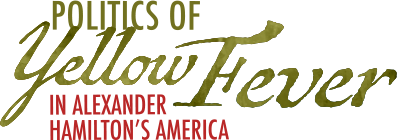Class 1: Explaining Yellow Fever – Localism v. Contagionism
Introduction:
This class begins with an overview of the devastating impact that yellow fever had on Philadelphia in 1793. Then, students investigate two competing theories that 18th century experts used to explain yellow fever: contagionism and localism. Suggested primary and secondary sources describe the intellectual, social, and religious foundations of each theory and their appeal. Students consider how, in a climate of uncertainty and fear, these theoretical models made the disaster manageable.
Class Resources
Readings
Secondary Sources
Secondary Sources
- Apel, Thomas A. Feverish Bodies, Enlightened Minds: Science and the Yellow Fever Controversy in the Early American Republic. Stanford, CA: Stanford University Press, 2016. pp. 11–34, 94–116
- Powell, J. H. Bring out Your Dead: The Great Plague of Yellow Fever in Philadelphia in 1793. Philadelphia: University of Pennsylvania Press, 1949. pp. v–x, 1–28
- Le Met, L., artist and engraver. [Benjamin Rush] Print. n.d. From U.S. National Library of Medicine: Digital Collections. http://resource.nlm.nih.gov/101428027
- Rush, Benjamin. “An Account of the Origin, Symptoms and Treatment of the Epidemic Fever, Which Now Prevails in the City of Philadelphia: In a Letter from Dr. Benjamin Rush to Dr. John Rodgers.” American Mercury. October 21, 1793.
- ———. Letter to his sister, September 18, 1793.
Discussion Questions
- How would you describe the city of Philadelphia during the epidemic? Use examples from both of Rush’s letters and Powell’s book.
- What role did Philadelphia’s “disputatious” public culture (Apel, p. 13) play in perpetuating uncertainty about the disease?
- Thomas Apel describes two competing theories of disease causation: localism and contagionism. What are the important characteristics of each? How did divine intervention figure into both viewpoints?
- On what points did contagionists and localists disagree? On what points did they agree? Provide examples from Apel’s book and Rush’s letters.
- What was the role of common sense (Apel, pp. 27–28) and fact (Apel, p. 17) in the work of yellow fever investigators? How did the priority ascribed to facts and common sense differ for localists and contagionists?
- Dr. Rush’s letter in the American Mercury appeared during the height of the epidemic. What purpose does this letter serve for Dr. Rush? Why did he mention his opponents?
- In his introduction, Powell says that Dr. Rush “knew that truth is no physical thing, but an element in the moral structure of life, unprovable, unseen” (p. x). Is that an accurate summary of Rush’s worldview? Why or why not?
- On page 100, Apel explains that a “curious combination of the natural and divine appears…in the letters of Benjamin Rush. Though Rush was well known for his numerous published writings about the natural causes of yellow fever and his strenuous defense of localism, his letters…preserve an entirely different conception of the pestilence, its cause, and its meaning.” What was that different conception? Point to evidence in support of Apel’s argument in Rush’s letter to his sister and the piece in The American Mercury.
- Read the postscript on Rush’s letter to his sister. Why do you think he asked that his sister destroy the letter?
- What examples of contemporary epidemics can you think of that experts explain in multiple ways?






